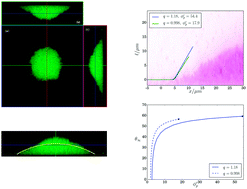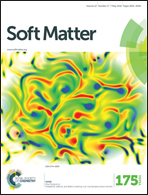Contact line of adsorbed colloid–polymer droplets in theory and experiment
Abstract
The contact line between the colloid-rich bulk liquid and an adsorbed thin film in colloid–polymer mixtures (CPM) is studied by means of an interface displacement model. The interface displacement profiles are compared to laser scanning confocal microscopy (LSCM) images. The mixtures consist of poly(methylmetacrylate) (PMMA) colloids and polystyrene (PS) polymers with polymer-to-colloid size ratio q = 1.18. Based on the experimental parameters, the theoretical model predicts a contact angle for colloid-rich liquid droplets adsorbed on glass of θ∞ = 59°, assuming a contact line with infinite radius, R = ∞. When a contact-line curvature correction and a correction for the protein-limit character of the CPM are taken into account, a modest shift is obtained. The refined theory predicts θ ≈ 56°. The contact angle determined visually from the LSCM images is θ ≈ 30°. The model predicts a three-phase contact-line tension of τ = −1.2 × 10−12 N (uncorrected) and τ = −2.3 × 10−13 N (with protein-limit correction), which is physically sound both in sign and magnitude. The line tension influences the contact angle to a small extent due to the contact line curvature. The predicted width of the transition zone between the thin film and the droplet is about 2 μm. The effect of gravity is noticeable as a deformation near the middle of the droplet.


 Please wait while we load your content...
Please wait while we load your content...